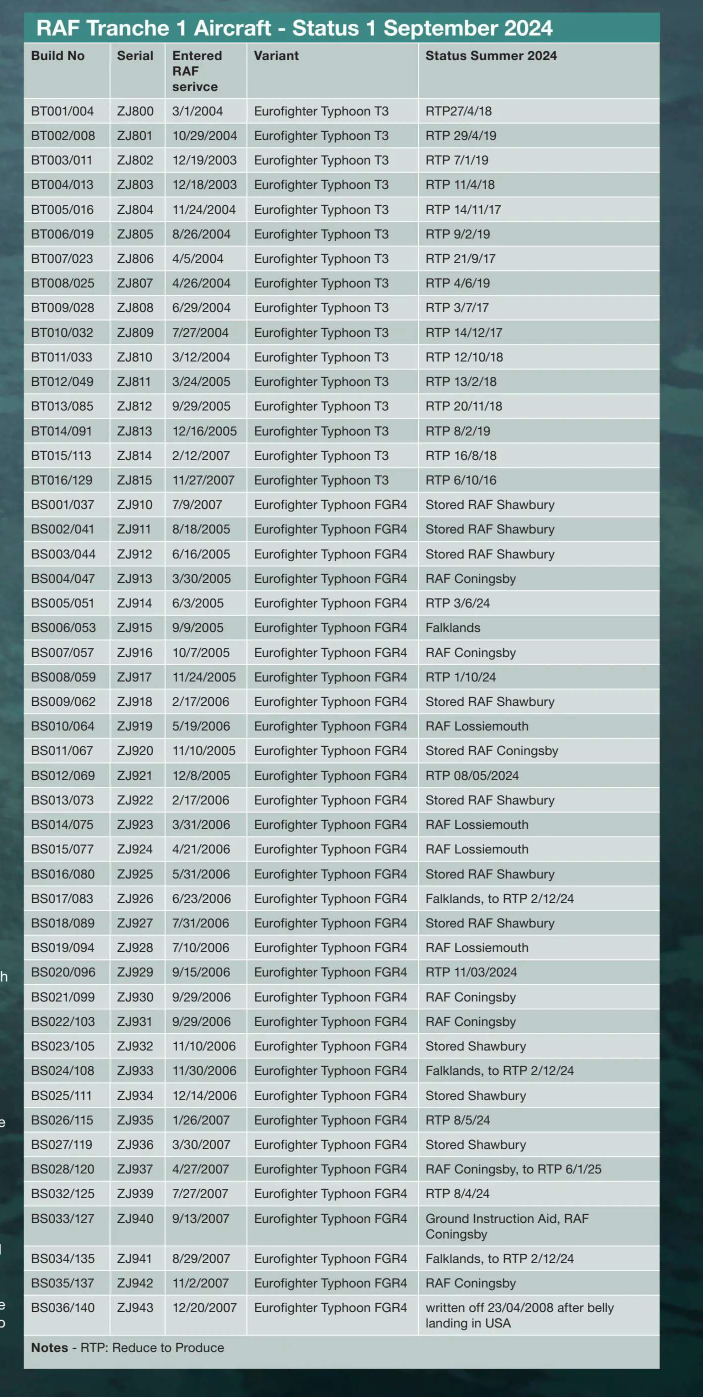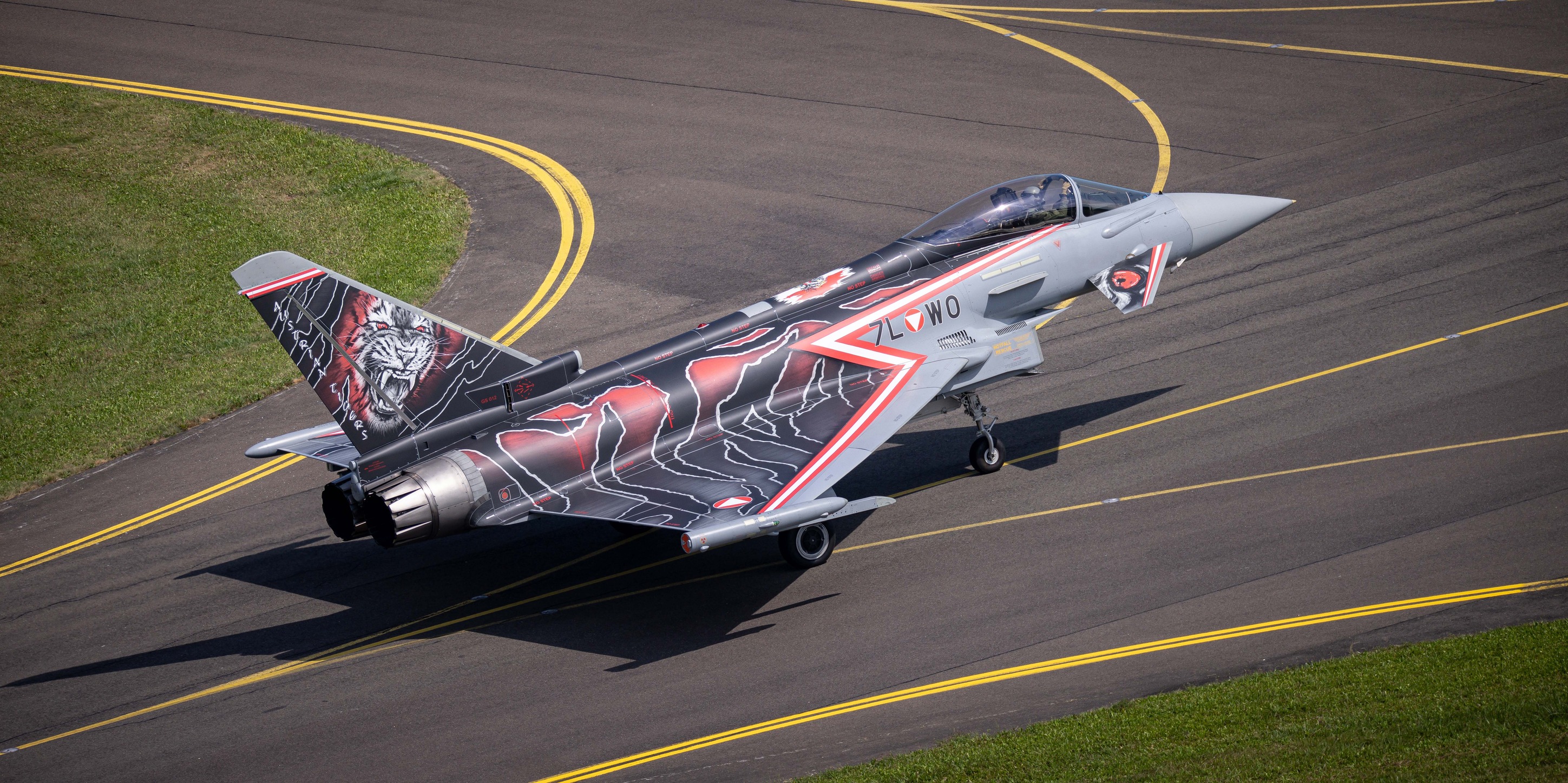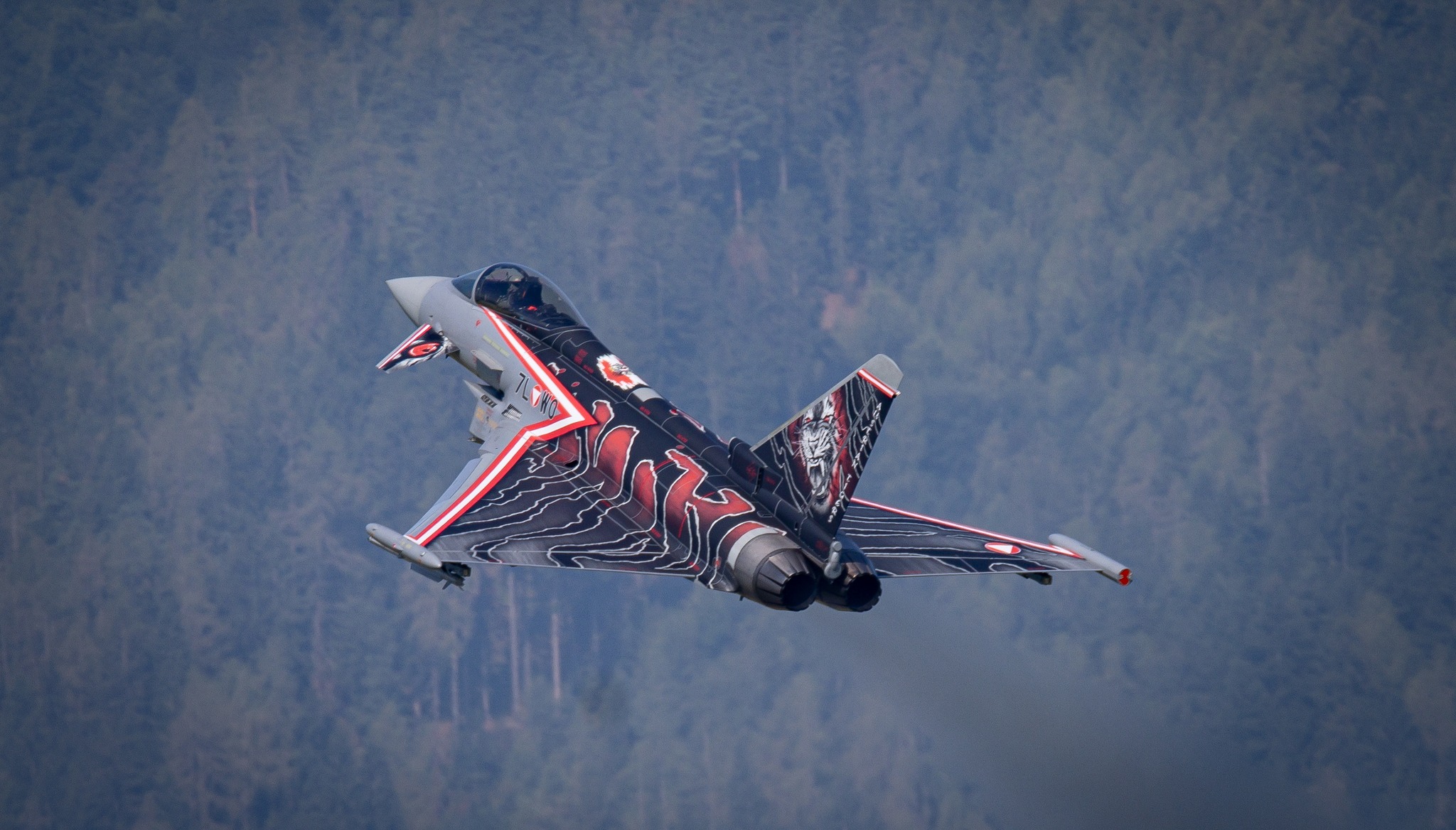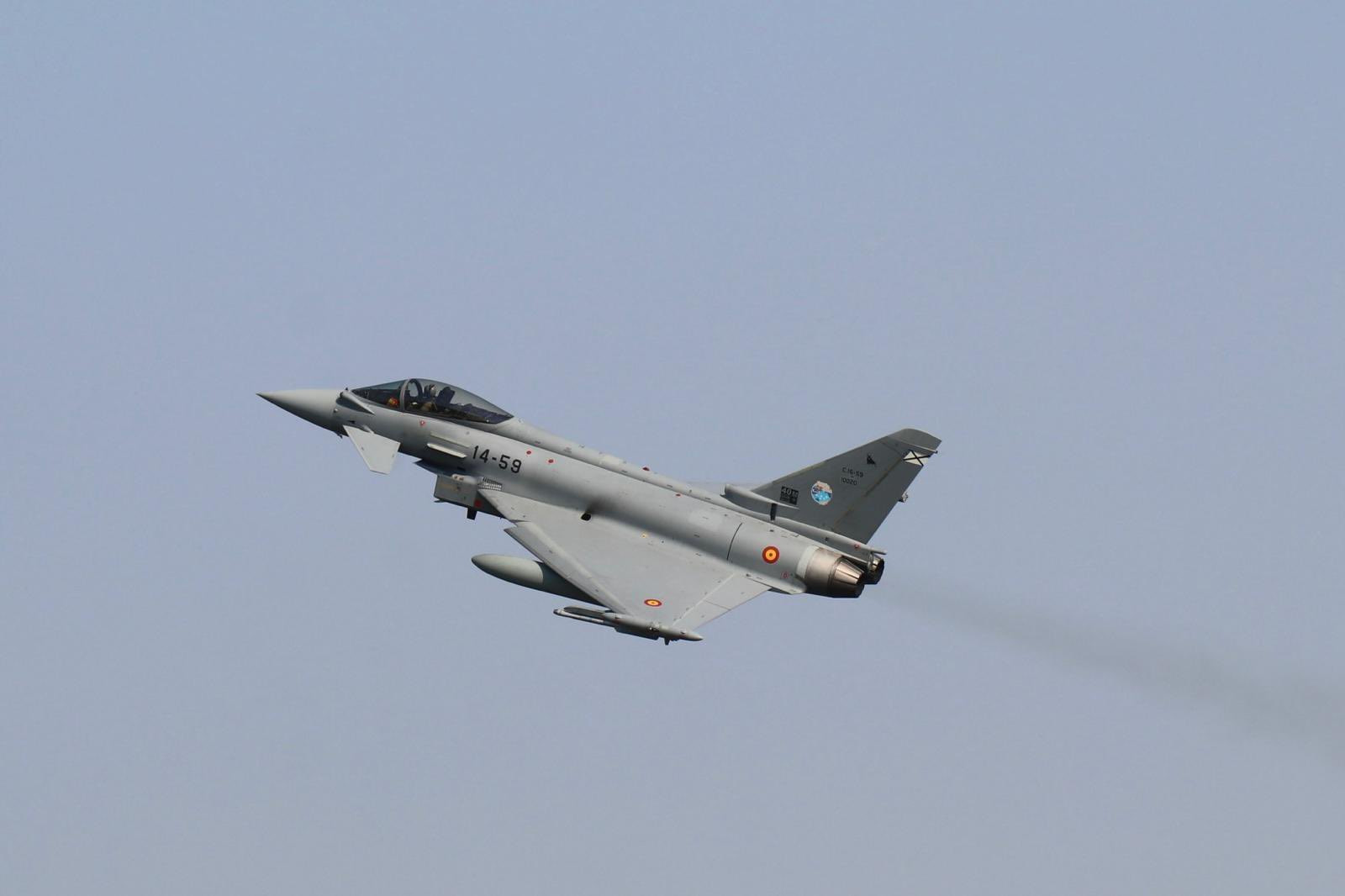Eurofighter EFA EF-2000 Typhoon
-
"Grey Tiger" de Austria: https://x.com/EuroAirshow/status/1824773156009070654
-
-
Parece que las negociaciones para la venta a Arabia Saudí todavía continúan: https://www.finanznachrichten.de/nachrichten-2006-04/6310632-uk-govt-says-saudi-typhoon-eurofighter-deal-still-in-negotiation-020.htm
-
Respecto a Turquía, continúa el interés en adquirir unas 40 unidades pero en palabras ministro Güler hay "pocos avances": https://ekonomi.haber7.com/foto-galeri/87419-turkiyenin-eurofighter-ve-kaan-planina-yakin-markaj-fazlasiyla-yeterli-olacak/p13
-
Las aeronaves italianas desplegadas en la campaña del Indio-Pacífico realizaron más de 270 misiones y 350 horas de vuelo: https://www.difesaonline.it/news-forze-armate/cielo/rientrati-italia-i-velivoli-e-il-personale-che-hanno-preso-parte-alla
-
-
-
- "Anécdotas de una vuelta al mundo en Eurofighter": https://www.infobae.com/espana/2024/09/07/anecdotas-de-una-vuelta-al-mundo-en-eurofighter-el-favor-de-la-fuerza-aerea-alemana-que-permitio-seguir-volando-a-un-caza-espanol/?outputType=amp-type
Por Gastón Trelles
...
Alaska fue uno de los muchos destinos a los que llegaron los pilotos españoles en el marco de Pacific Skies y, desde allí, debían continuar viaje hasta Japón. No obstante, en la víspera a emprender el vuelo a tierras niponas el personal de mantenimiento descubrió que uno de los cuatro cazas con los que contaba España presentaba un desperfecto en una de sus turbinas, como consecuencia del impacto contra un ave.“El cartucho que recopila todos los datos de vuelo fue el que alertó a los mecánicos que había habido una ingesta de pájaro y que ese motor ya no se podía seguir usando”, explica a Infobae España el teniente Pérez López, el piloto del Ala 14 que volaba el avión al momento del impacto. “No sé en qué momento fue. Hasta que no me dijo el mecánico yo no me di cuenta”, detalla el aviador, quien achaca a “la robustez y fiabilidad” del Eurofighter el haber podido concluir el vuelo sin problema alguno. Sin embargo, ese motor no podría soportar las siete horas y media de vuelo hasta Japón.
- Eurofighter alemanes han practicado operaciones desde carreteras en Finlandia junto con F-35A, F-18, Hawk y Learjet. Después de aterrizar, fueron repostados con los motores encendidos y despegaron de nuevo: https://aerobuzz.de/militar/eurofighter-und-f-35a-landen-in-finnland-auf-der-landstrasse/
-
El primer Eurofighter de la RAF equipado con el nuevo radar AESA ECRS Mk2 se prepara para sus vuelos de pruebas.

El primer Eurofighter de la RAF equipado con el nuevo radar AESA ECRS Mk2 se prepara para sus vuelos de pruebas. – Galaxia Militar
El programa de modernización de radar de los cazas Eurofighter de la Real Fuerza Aérea británica (RAF) continúa a buen ritmo.

Galaxia Militar (galaxiamilitar.es)
-
Mucho programa multinacional europeo, pero desarrollando dos radares AESA.
Del que supuestamente equipara al EdA no se sabe nada aún de vuelos y tal.
https://www.hensoldt.net/products/radar-iff-and-comms/eurofighter-ecrs-mk1-active-aesa-nose-radar-for-eurofighter-combat-aircraft/ -
La Luftwaffe dice que tiene la intención de aumentar el alcance de Eurofighter EK , lo que confirma el plan del "Paso 2" de agregar pods inhibidores de escolta y MUM-T además de Arexis y AARGM del "Paso 1". Sin embargo, no hay compromisos sobre números.
https://x.com/GarethJennings3/status/1846123791077785808 -
Prácticamente la Tranche 1 de la RAF está fuera de servicio ,desmantelándose para obtener piezas.

-
Alemania levanta el veto a la venta de 40 cazas Eurofighter a Turquía que negocian España y Reino Unido
Alemania levanta el veto a la venta de 40 cazas Eurofighter a Turquía que negocian España y Reino Unido
En este caso, el veto lo levantó el pasado enero, en el marco de la contribución que Riad ha estado prestando a la seguridad israelí, al impedir los ataques hutíes de Yemen, y, de fondo, con ...
Infodefensa - Noticias de defensa, industria, armamento y ejércitos (www.infodefensa.com)
-
Yo me llevaría una sorpresa si Turquía compra EF. Creo que es simplemente una estrategia para que USA afloje con los F16, y si puede ser con los F35, que bastante dinero han puesto.
-
Si no mencionas a los malos EEUU y el F-35 te da algo, lo tuyo es enfermizo.
El F-35 no irá a Turquía, sino se entrega la batería de S400, y aún así, sería un error hacerlo ante un socio que no es defiar.
-
No tiene porqué,los Turcos siempre han tenido una pequeña ensalada montada,F16,F4...
Puede ser una buena manera de obtener apoyo político y transferencias tecnológicas.
Saludos.
-
Si no mencionas a los malos EEUU y el F-35 te da algo, lo tuyo es enfermizo.
El F-35 no irá a Turquía, sino se entrega la batería de S400, y aún así, sería un error hacerlo ante un socio que no es defiar.
Tu opinas que los turcos van a comprar EF??
-
Lo dudo, parece una táctica que bajen el precio al F-35 que es el que siempre han querido y pagado por ello, los turcos estuvieron desde los inicios en el proyecto
-
Lo dudo, parece una táctica que bajen el precio al F-35 que es el que siempre han querido y pagado por ello, los turcos estuvieron desde los inicios en el proyecto
Más que bajar el precio, que se los den.
Y para que les desbloqueen todo el tema del F16, que ha estado varios años bloqueado por el gobierno USA. Esto incluso más.
Amagan con irse a otra cosa. Pero no se van a ir. Ahora ya han dicho que almacenan los S400. Tanto dinero para nada.

Turkish F-16 modernization program encounters roadblocks | eKathimerini.com
Six months after Washington’s green light for the modernization of Turkish F-16s, the program appears to have encountered roadblocks, it was reported on Wednesday.
(www.ekathimerini.com)
Seis meses después de la luz verde de Washington para la modernización de los F-16 turcos, el programa parece haber encontrado obstáculos, se informó el miércoles.
Según los informes, Turquía tiene dudas sobre la compra de nuevos aviones de combate F-16 y la actualización de los existentes a la configuración Viper, con Ankara buscando otras opciones e incluso considerando desechar el programa por completo.
El presidente turco Erdogan ha reconocido los problemas después de la conclusión de la Cumbre de la OTAN, solicitando la intervención del presidente estadounidense Biden. Las dos partes parecen diferir en muchos temas del programa de 23 mil millones de dólares, como la producción nacional y los tiempos de entrega de la aeronave.
Ankara desea producir nacionalmente los 40 nuevos F-16 Vipers que comprará a los Estados Unidos, mientras que el gobierno de los Estados Unidos quiere asignar la producción a Lockheed Martin. Turquía cree que la producción nacional de los aviones de combate reducirá significativamente los costos y los tiempos de entrega. Se estima que en las condiciones actuales, las primeras viperas turcas estarán listas para 2030.
-
Ni en Washington ni en Bruselas gusta el presidente Erdogan.
No creo que cambie mucho la cosa, salvo victoria de Trump que con el todo puede pasar.
-
Firmados los 25 Halcon 2.
-
Lo mas interesante es lo que indica a continuación, con las posibles ventas a otros estados ( lo de polonia no lo veo)
-
Tampoco la de Turquía, que lleva años hablando de una posible compra pero que dispone de un caza propio y está modernizando sus F-16. Arabia Saudí y sobre todo Catar me parecen más viables.
-
Tampoco la de Turquía, que lleva años hablando de una posible compra pero que dispone de un caza propio y está modernizando sus F-16. Arabia Saudí y sobre todo Catar me parecen más viables.
@Alejandro_ dijo en Eurofighter EFA EF-2000 Typhoon:
Tampoco la de Turquía, que lleva años hablando de una posible compra pero que dispone de un caza propio y está modernizando sus F-16. Arabia Saudí y sobre todo Catar me parecen más viables.
Hay otra variable. Se comenta que los turcos también estarían buscando Eurofighter en el mercado de segunda mano de Oriente Medio (del traductor): https://tolgaozbek.com/savunma/eurofighterda-ilk-adim-ikinci-el/
Tolga Özbek hace 4 semanas
Primer paso Eurofighter de segunda mano
Según el plan, en la primera etapa la Fuerza Aérea turca comprará un Eurofighter de segunda mano a un país del Golfo. Cabe señalar que el número puede variar entre 20 y 12. Actualmente, Arabia Saudita tiene 72 Eurofighters, Kuwait 28, Qatar 24 y Omán 12. Posteriormente, se pretende que el número aumente a 40.
Las empresas de defensa turcas están sobre la mesa
En los últimos años, Türkiye ha desarrollado muchas infraestructuras de defensa diferentes, desde municiones hasta software, desde radares hasta sistemas electrónicos, con recursos locales y nacionales. La condición más importante para la compra es la integración de estos sistemas en los aviones Eurofighter.
Respecto a esta cuestión, los equipos de las empresas de defensa turcas como ASELSAN, Roketsan y HAVELSAN han mantenido reuniones con equipos de Eurofighter en las últimas semanas. Una de las condiciones importantes de Turquía para la integración es que quiere que se incluyan en el avión sistemas nacionales y nacionales.
-
La negociación con Turquía la lleva RU así que posiblemente la variante ofertada sea la suya (nueva computadora de misión unificada, radar Mk2, LAD y software bajo su arquitectura abierta y modular Pyramid): https://www.reuters.com/business/aerospace-defense/germany-says-britain-taking-lead-possible-eurofighters-turkey-2024-10-19/
-
Por otra parte, tras el primer vuelo del Mk2, ya hay quien lo apoda el "Frankenradar". Un buen artículo al respecto, donde se afirma que las primeras unidades que recibiremos estarán equipadas con el Mk0 para actualizarse después: https://aerospaceglobalnews.com/news/advanced-frankenradar-prototype-for-typhoon/
The prototype of the advanced new ECRS.Mk 2 radar for Typhoon flew for the first time from BAE Systems’ Warton Aerodrome on Friday 27 September. The first Tranche 3 Typhoon the first Tranche 3 Typhoon (ZK355/BS116), flown by Luke Gili-Ross, took off at 1500 for the first flight of the prototype radar. This was probably as much a shakedown flight for the aircraft as it was a serious radar test flight, after what has been a fairly long lay up.
...
A Typhoon equipped with ECRS Mk 2 will be a very survivable platform, so, while the enemy may know that the aircraft is ‘in the area’, its pilot will not have to worry about the aircraft’s signature. A Typhoon formation with ECRS.Mk 2 will be able to operate as what one programme insider described as the “brute squad”, and what one RAF senior officer called “the thug”. The Typhoon will carry large numbers of weapons and “rain down electronic attack and the world’s supply of SPEAR Capability III or SDBs or whatever weapon you want to use, while the fifth-gen aircraft is acting as a silent assassin, sliding around the back to slip the knife in!”
...
Work on an AESA radar for Typhoon began in 2002 with the British and German industry Captor E-Scan Risk Reduction (CECAR) project, which aimed to develop an AESA derivative of the existing Captor, adding a new AESA antenna to the existing Captor-D ‘back end’. A Captor AESA Radar (CAESAR) demonstrator flew on board a UK Ministry of Defence-operated (MoD) BAC One-Eleven on February 24, 2006 and was later flown on the Eurofighter Development Aircraft DA5, beginning on May 8, 2007. At this point the proposed CAESAR-based AESA solution for the Eurofighter incorporated a fixed antenna (like most AESA designs), but the UK, in particular, felt that such an antenna would be handicapped by a more limited scan in azimuth and by reduced range at the edges of azimuth coverage.To overcome this limitation, Euroradar explored a number of ‘moving AESA’ designs, using a single or double swashplate wide field of regard (WFoR) re-positioner to provide much wider scan limits. The eventual Captor-E was developed using just such a double swashplate re-positioner.
Eurofighter and the NATO Eurofighter and Tornado Management Agency (NETMA) signed a €1bn contract to develop the electronically scanned Captor-E radar on November 19, 2014. Initially, several versions of the basic Captor-E were envisaged to meet different customer requirements, as variants of what was referred to as a European Common Radar System (ECRS).
Competing visions of a Typhoon AESA led to delays, but Eurofighter finally established an AESA radar roadmap in 2012, and a baseline Captor-E AESA radar was developed on a four-nation basis. This now incorporated a dual-swashplate mechanical re-positioner, meaning that the radar ‘beam’ was steered both mechanically and electronically, allowing higher off-boresight angles to be reached, and improving range at high azimuth limits.
Work on Captor-E began using industry funding and an initial radar was fitted to a UK-based Typhoon test aircraft, Instrumented Production Aircraft (IPA) 5 (ZJ700), in time to be shown on static display at the 2014 Farnborough International Airshow. Flight trials began on July 8, 2016, out of BAE Systems’ Warton aerodrome. A German Tranche 3 Eurofighter, IPA8, operated by Airbus Defence and Space, joined the test programme from September 2016, flying from Manching.
The first production variant of the new Captor-E AESA radar (known as Radar One Plus and later as ECRS Mk 0) was developed primarily to meet the requirements of Kuwait and Qatar, and is now in full frontline service. The first Typhoon in Kuwait Air Force configuration – Instrumented Series Production Aircraft (ISPA) 6 – joined the test effort on December 23, 2019. It conducted the so-called ‘E-scan XCR#1’ flight test campaign in March 2020, completing E-scan entry-into-service flight tests and readying the way for deliveries to Kuwait, though these were then delayed by COVID-19.
Hensoldt is developing a new ECRS Mk 1 AESA radar for the German and Spanish Eurofighter fleets. This is a development of the Kuwait/Qatar ECRS.Mk 0, with a new digital multi-channel receiver and new transmitter/receiver LRIs. The German and Spanish aircraft will initially be fitted with exactly the same Mk 0 radar as that supplied to Kuwait and Qatar, but their radars will subsequently be upgraded to Mk 1 standard by retrofitting the new items.
...
On 3 September 2020, the UK Ministry of Defence announced that it had awarded BAE Systems and Leonardo a £317m contract to ‘develop’ a next-generation radar for the Royal Air Force’s Eurofighter Typhoon fleet. In fact, development was already underway, a programme insider noting that this September 2020 contract was the fifth cycle of activity that he had personally seen on ECRS Mk 2!The contract actually covered the integration by BAE Systems of the new Leonardo developed ECRS Mk 2 E-scan radar on the Typhoon, to meet RAF requirements. This test and evaluation contract for ‘Radar Two’ reportedly included the production of five radar sets for flight trials (three of them production standard radars), and some long lead items for production radars. The plan is still to retrofit all 40 of the UK’s Tranche 3 Typhoons with ECRS Mk 2, although there is an option to re-equip Tranche 2 Typhoons as well. Both tranches have the necessary pre-mods to allow the retrofit, but the decision does not need to be made yet.
...
The schedule and planned timeline had been maintained up to that point, giving a degree of confidence that the initial operational capability (IOC) date would be achieved. In fact, when the stimulus of the Finnish HX competition disappeared, funding slowed, and priorities changed. The scheduled 2022 first flight was not achieved, while the planned IOC date for the ECRS.Mk 2 has slipped from soon after 2025 to 2030.
...
Instead, Radar Two uses a completely new open-architecture back end, with a completely new processor and receiver, as well as a dedicated EW receiver and techniques generator. This is married to what Leonardo has referred to as a ‘revolutionary’ multi-function array. This will incorporate both gallium arsenide (GaAs) and gallium nitride (GaN) semi-conductors, blending the strengths of these two different technologies to cost-effectively provide a differentiating military capability. Radar Two also employs a completely different system for its antenna re-positioner, using a single rotating joint, like that used on the ES-05 Raven radar fitted to the Gripen E, rather than the double swashplate arrangement of the Captor-E. The aircraft also has a new radome tailored to support the ECRS Mk 2’s wide bandwidth.
...
The prototype ECRS.Mk 2 is something of a ‘Frankenradar’, incorporating the antenna from the old Bright Adder technology demonstrator and an existing ECRS.Mk 0 ‘back end’!This is perhaps appropriate, as the ECRS.Mk 2 was derived in part from the Advanced Radar Targeting System (ARTS) and Bright Adder technology demonstrators, and not from the original Captor-C/D radar or the AESA-equipped Captor-E. Although built as a flyable asset, the Bright Adder radar was not flown, however, instead being used in Leonardo’s roof lab at Crewe Toll in Edinburgh, where it successfully demonstrated novel ‘jamming through the radar’ techniques and functionality.
-






